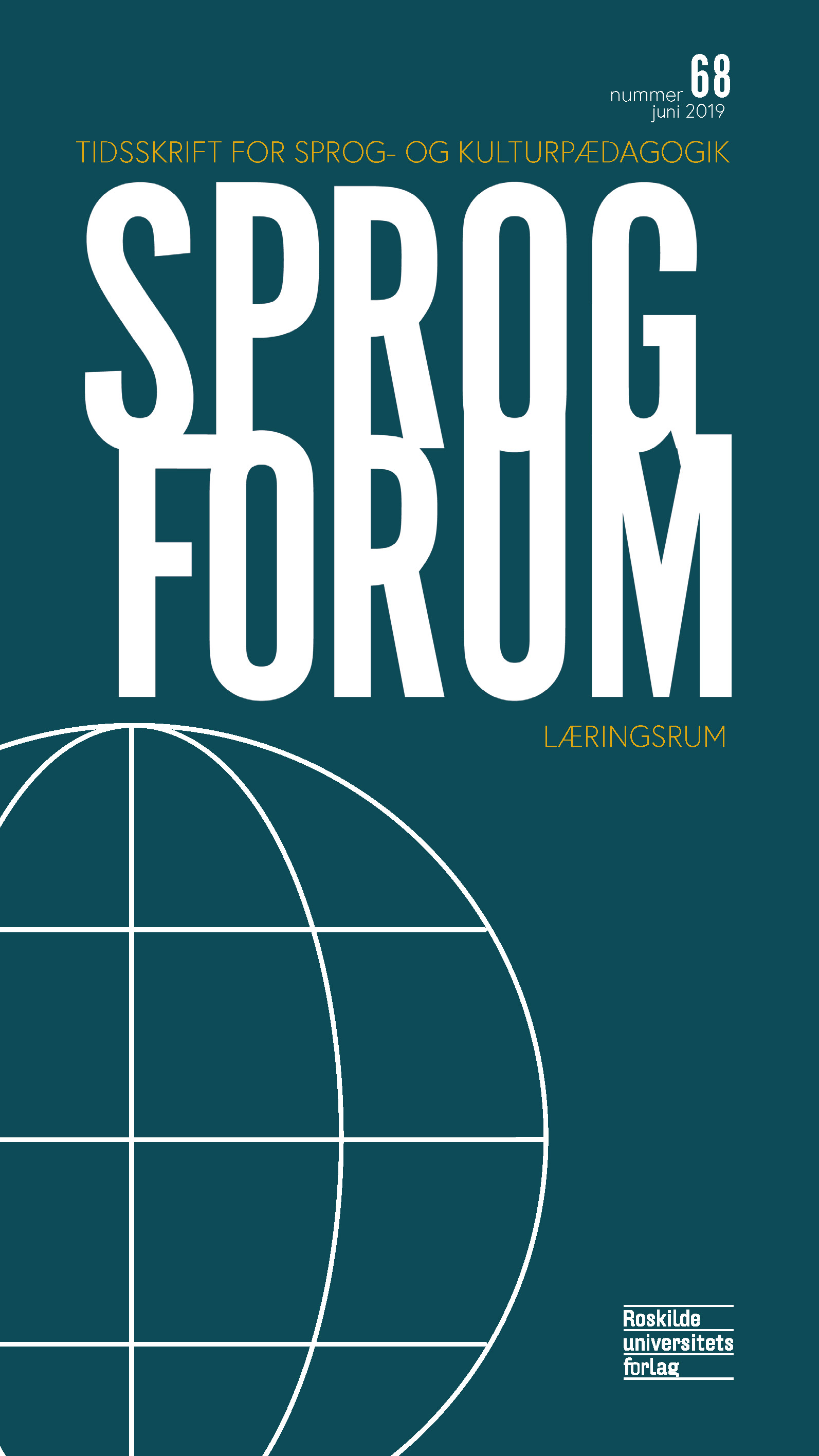Temanyt 68
Læringsrum
DOI:
https://doi.org/10.7146/spr.v25i68.128638Referencer
Alterator, S. & Deed, C. (2018). School space and its occupation: Conceptualising and evaluating innovative learning environments. Boston: Brill Sense.
Andersen, G. & Antorini, C. (2017). Kloge kvadratmeter: Skjulte ressourcer til bedre læringsmiljøer. Odense: Praxis – Erhvervsskolernes Forlag.
Babione, C. & Anderkin, K. (2015). Practitioner teacher inquiry and research. San Francisco: Jossey-Bass.
Barnard, R. & Torres-Guzmán, M.E. (2009). Creating classroom communities of learning: International case studies and perspectives. Bristol: Multicultural Matters.
Bertin, J., Grave, P. & Narcy-Combes, J. (2010). Second language distance learning and teaching: Theoretical perspectives and didactic ergonomics. Hershey: Information Science Reference.
Bibby, T. (2017). The creative self: Psychoanalysis, teaching and learning in the classroom. Abingdon, Oxon: Routledge.
Bojsen, H. (red.) (2018). Hvis du ikke kan sproget … Om flersprogethed og læring på RUC’s Sprogprofiler. Frederiksberg: Roskilde Universitetsforlag.
Burke, M., Fialho, O. & Zyngier, S. (2016). Scientific approaches to literature in learning environments. Amsterdam: John Benjamins Publishing Company.
Burns, A. (2010). Doing action research in English language teaching: A guide for practitioners. New York: Routledge.
Cavanagh, R.F. & Waugh, R. (2011). Applications of Rasch measurement in learning environments research. Rotterdam: Sense Publishers.
Cook, V. & Li, W. (2016). The Cambridge Handbook of linguistic multicompetence. Cambridge: Cambridge University Press.
Fabricius, A.H. & Preisler, B. (2015). Transcultural interaction and linguistic diversity in higher education: The student experience. Basingstoke: Palgrave Macmillan.
Friis, K., Østergren-Olsen, D. & Friis, K. (red.) (2018). Literacydidaktik i fagene på mellemtrinnet. Frederikshavn: Dafolo.
García, O., Johnson, S.I. & Seltzer, K. (2017). The translanguaging classroom: Leveraging student bilingualism for learning. Philadelphia: Caslon.
Gibbons, P. (2015). Scaffolding language, scaffolding learning: Teaching English language learners in the mainstream classroom (2. udg.). Portsmouth: Heinemann.
Gibbons, P. (2016). Styrk sproget, styrk læringen: Sproglig udvikling og stilladsering i flersprogede klasserum (2. udg.). Frederiksberg: Samfundslitteratur.
Gregersen, A.S. (red.) (2017). Tidlig sprogstart i skolen. Frederiksberg: Samfundslitteratur.
Gruba, P. & Hinkelman, D. (2012). Blending technologies in second language classrooms. New York: Palgrave Macmillan.
Gurung, R.A.R. & Prieto, L.R. (2009). Getting culture: Incorporating diversity across the curriculum. Sterling: Stylus.
Hamilton, M. (2014). Autonomy and foreign language learning in a virtual learning environment. London: Bloomsbury Academic.
Hui, M. & Grossman, D.L. (2008). Improving teacher education through action research. New York: Routledge.
Hunsinger, J. & Krotoski, A. (2012). Learning and research in virtual worlds. London: Routledge.
Jensen, I.F. & Petersen, K. (2012). Toolbox til KIE-modellen – gymnasiet. Køge: KreaConsult +Education.
Keppell, M., Souter, K. & Riddle, M. (2012). Physical and virtual learning spaces in higher education: Concepts for the modern learning environment. Hershey: IGI Global.
Lunde, M. & Aamodt, S. (2017). Inkluderende og flerspråklig opplæring. Bergen: Fagbokforlaget.
Mazak, C. & Carroll, K.S. (2016). Translanguaging in higher education beyond monolingual ideologies. Bristol: Multilingual Matters.
McMillan, J.H. (2017). Using students’ assessment mistakes and learning deficits to enhance motivation and learning. New York: Routledge.
Murray, G., Gao X. & Lamb, T. (2011). Identity, motivation and autonomy in language learning. Bristol: Multilingual Matters.
Nielsen, G.Ø., Pedersen, M.S. & Lund, K. (2003). Individuelle læringsplaner og kollektive læringsrum – en vejledning. København: Integrationsministeriet.
Nikula, T., Dafouz, E., Moore, P. & Smit, U. (2016). Conceptualising integration in CLIL and multilingual education. Bristol: Multilingual Matters.
Norton, B. & Toohey, K. (2004). Critical pedagogies and language learning. Cambridge: Cambridge University Press.
Pedersen, M.P. (red.) (2007). På vej med sproget: Arbejde, livshistorie og sproglæring. København: Ministeriet for Flygtninge, Indvandrere og Integration.
Quintero, E. (2017). Teaching in context: The social side of education reform. Cambridge: Harvard Education Press.
Rander, H., Boysen, L. & Goldbech, O. (2018). Voksendidaktik. København: Akademisk Forlag.
Sadler, R. (2012). Virtual worlds for language learning: From theory to practice. Bern: Lang.
Schnotz, W. (2015). Multidisciplinary research on teaching and learning. Basingstoke: Palgrave Macmillan.
Schunk, A. (red.) (2016). Flip din undervisning: En antologi om flipped classroom og flipped learning. Aarhus: Turbine Akademisk.
Sherris, A. & Adami, E. (2019). Making signs, translanguaging ethnographies: Exploring urban, rural and educational spaces. Bristol: Multilingual Matters.
Streeck, J., Goodwin, C. & LeBaron, C.D. (2011). Embodied interaction: Language and body in the material world. New York: Cambridge University Press.
Tay, L.Y. & Lim, C.P. (2013). Creating holistic technology-enhanced learning experiences: Tales from a future school in Singapore. Rotterdam: Sense Publishers.
Thomas, M. (2009). Handbook of research on Web 2.0 and second language learning. Hershey: Information Science Reference.
Thomas, M. & Reinders, H. (2010). Task-based language learning and teaching with technology. London: Continuum.
Trinder, R. (2006). Language learning with computers: The students’ perspective: A theoretical and empirical investigation. Frankfurt am Main: Lang.
Ubell, R. (2017). Going online: Perspectives on digital learning. New York: Routledge. Van Lier, L. (2004). The ecology and semiotics of language learning: A sociocultural perspective. Boston: Kluwer Academic.
Wittek, L. (2012). Læring i og mellom mennesker: En innføring i sosiokulturelle perspektiver (2. udg.). Oslo: Cappelen Damm akademisk.
Østern, A., Sjöholm, K. & Arnolds-Granlund, S. (2006). Kulturella mötesplatser i tid och rum. Vasa: Åbo Akademi, Pedagogiska fakulteten.
Yderligere filer
Publiceret
Citation/Eksport
Nummer
Sektion
Licens
Fra 2024 deles ophavsretten mellem forfatteren og Forlaget Sprogforum.
Artikler udgivet i Sprogforum må citeres, downloades og videresendes for ikke-kommerciel brug, under forudsætning af normal akademisk reference til forfatter(e) samt tidsskrift, årgang, nummer og sider. Artiklerne må kun genudgives med eksplicit tilladelse fra forfatter(e) og tidsskriftet.
Til og med 2023 Deles ophavsretten mellem forfatteren og Roskilde Universitetsforlag.





